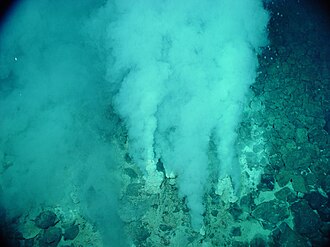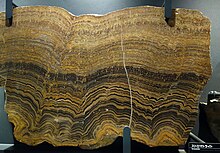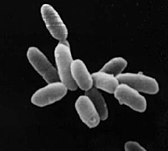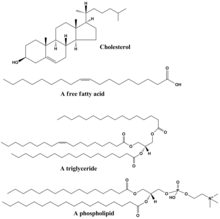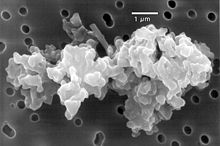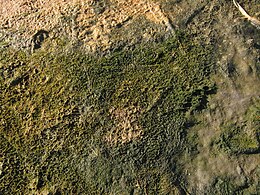
The Proterozoic is the third of the four geologic eons of Earth's history, spanning the time interval from 2500 to 538.8 Mya, the longest eon of the Earth's geologic time scale. It is preceded by the Archean and followed by the Phanerozoic, and is the most recent part of the Precambrian "supereon".

The Archean Eon, in older sources sometimes called the Archaeozoic, is the second of the four geologic eons of Earth's history, preceded by the Hadean Eon and followed by the Proterozoic. The Archean represents the time period from 4,031 to 2,500 Ma. The Late Heavy Bombardment is hypothesized to overlap with the beginning of the Archean. The Huronian glaciation occurred at the end of the eon.

Stromatolites or stromatoliths are layered sedimentary formations (microbialite) that are created mainly by photosynthetic microorganisms such as cyanobacteria, sulfate-reducing bacteria, and Pseudomonadota. These microorganisms produce adhesive compounds that cement sand and other rocky materials to form mineral "microbial mats". In turn, these mats build up layer by layer, growing gradually over time. This process generates the characteristic lamination of stromatolites, a feature that is hard to interpret, in terms of its temporal and environmental significance. Different styles of stromatolite lamination have been described, which can be studied through microscopic and mathematical methods. A stromatolite may grow to a meter or more. Fossilized stromatolites provide important records of some of the most ancient life. As of the Holocene, living forms are rare.

Geomicrobiology is the scientific field at the intersection of geology and microbiology and is a major subfield of geobiology. It concerns the role of microbes on geological and geochemical processes and effects of minerals and metals to microbial growth, activity and survival. Such interactions occur in the geosphere, the atmosphere and the hydrosphere. Geomicrobiology studies microorganisms that are driving the Earth's biogeochemical cycles, mediating mineral precipitation and dissolution, and sorbing and concentrating metals. The applications include for example bioremediation, mining, climate change mitigation and public drinking water supplies.

The Paleoarchean, also spelled Palaeoarchaean, is a geologic era within the Archean Eon. The name derives from Greek "Palaios" ancient. It spans the period of time 3,600 to 3,200 million years ago. The era is defined chronometrically and is not referenced to a specific level of a rock section on Earth. The earliest confirmed evidence of life comes from this era, and Vaalbara, one of Earth's earliest supercontinents, may have formed during this era.

Geobiology is a field of scientific research that explores the interactions between the physical Earth and the biosphere. It is a relatively young field, and its borders are fluid. There is considerable overlap with the fields of ecology, evolutionary biology, microbiology, paleontology, and particularly soil science and biogeochemistry. Geobiology applies the principles and methods of biology, geology, and soil science to the study of the ancient history of the co-evolution of life and Earth as well as the role of life in the modern world. Geobiologic studies tend to be focused on microorganisms, and on the role that life plays in altering the chemical and physical environment of the pedosphere, which exists at the intersection of the lithosphere, atmosphere, hydrosphere and/or cryosphere. It differs from biogeochemistry in that the focus is on processes and organisms over space and time rather than on global chemical cycles.

The important sulfur cycle is a biogeochemical cycle in which the sulfur moves between rocks, waterways and living systems. It is important in geology as it affects many minerals and in life because sulfur is an essential element (CHNOPS), being a constituent of many proteins and cofactors, and sulfur compounds can be used as oxidants or reductants in microbial respiration. The global sulfur cycle involves the transformations of sulfur species through different oxidation states, which play an important role in both geological and biological processes. Steps of the sulfur cycle are:

The Gunflint chert is a sequence of banded iron formation rocks that are exposed in the Gunflint Range of northern Minnesota and northwestern Ontario along the north shore of Lake Superior. The Gunflint Chert is of paleontological significance, as it contains evidence of microbial life from the Paleoproterozoic. The Gunflint Chert is composed of biogenic stromatolites. At the time of its discovery in the 1950s, it was the earliest form of life discovered and described in scientific literature, as well as the earliest evidence for photosynthesis. The black layers in the sequence contain microfossils that are 1.9 to 2.3 billion years in age. Stromatolite colonies of cyanobacteria that have converted to jasper are found in Ontario. The banded ironstone formation consists of alternating strata of iron oxide-rich layers interbedded with silica-rich zones. The iron oxides are typically hematite or magnetite with ilmenite, while the silicates are predominantly cryptocrystalline quartz as chert or jasper, along with some minor silicate minerals.

The Great Oxidation Event (GOE) or Great Oxygenation Event, also called the Oxygen Catastrophe, Oxygen Revolution, Oxygen Crisis or Oxygen Holocaust, was a time interval during the Early Earth's Paleoproterozoic era when the Earth's atmosphere and the shallow ocean first experienced a rise in the concentration of oxygen. This began approximately 2.460–2.426 Ga (billion years) ago during the Siderian period and ended approximately 2.060 Ga ago during the Rhyacian. Geological, isotopic, and chemical evidence suggests that biologically produced molecular oxygen (dioxygen or O2) started to accumulate in Earth's atmosphere and changed it from a weakly reducing atmosphere practically devoid of oxygen into an oxidizing one containing abundant free oxygen, with oxygen levels being as high as 10% of their present atmospheric level by the end of the GOE.

The oldest dated rocks formed on Earth, as an aggregate of minerals that have not been subsequently broken down by erosion or melted, are more than 4 billion years old, formed during the Hadean Eon of Earth's geological history, and mark the start of the Archean Eon, which is defined to start with the formation of the oldest in-tact rocks on Earth. Meteorites that were formed in other planetary systems can pre-date Earth. Particles from the Murchison meteorite were dated in January 2020 to be 7 billion years old.
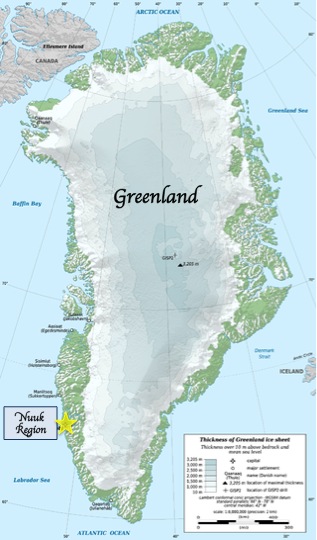
The Isua Greenstone Belt is an Archean greenstone belt in southwestern Greenland, aged between 3.7 and 3.8 billion years. The belt contains variably metamorphosed mafic volcanic and sedimentary rocks, and is the largest exposure of Eoarchaean supracrustal rocks on Earth. Due to its age and low metamorphic grade relative to many Eoarchaean rocks, the Isua Greenstone Belt has become a focus for investigations on the emergence of life and the style of tectonics that operated on the early Earth.
Early Earth is loosely defined as encompassing Earth in its first one billion years, or gigayear (Ga, 109 y), from its initial formation in the young Solar System at about 4.55 Ga to some time in the Archean eon in approximately 3.5 Ga. On the geologic time scale, this comprises all of the Hadean eon, starting with the formation of the Earth about 4.6 billion years ago, and the Eoarchean, starting 4 billion years ago, and part of the Paleoarchean era, starting 3.6 billion years ago, of the Archean eon.

The Pilbara Craton is an old and stable part of the continental lithosphere located in the Pilbara region of Western Australia.
The history of life on Earth traces the processes by which living and fossil organisms evolved, from the earliest emergence of life to present day. Earth formed about 4.5 billion years ago and evidence suggests that life emerged prior to 3.7 Ga. Although there is some evidence of life as early as 4.1 to 4.28 Ga, it remains controversial due to the possible non-biological formation of the purported fossils.

A microbial mat is a multi-layered sheet of microorganisms, mainly bacteria and archaea, or bacteria alone. Microbial mats grow at interfaces between different types of material, mostly on submerged or moist surfaces, but a few survive in deserts. A few are found as endosymbionts of animals.
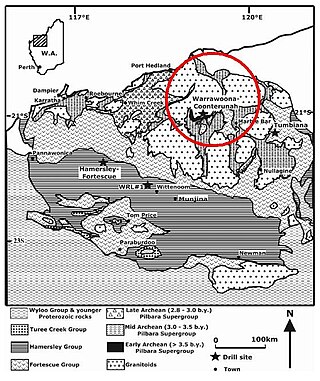
The Warrawoona Group is a geological unit in Western Australia containing putative fossils of cyanobacteria cells. Dated 3.465 Ga, these microstructures, found in Archean chert, are considered to be the oldest known geological record of life on Earth.
The Boring Billion, otherwise known as the Mid Proterozoic and Earth's Middle Ages, is the time period between 1.8 and 0.8 billion years ago (Ga) spanning the middle Proterozoic eon, characterized by more or less tectonic stability, climatic stasis, and slow biological evolution. It is bordered by two different oxygenation and glacial events, but the Boring Billion itself had very low oxygen levels and no evidence of glaciation.

The Barberton Greenstone Belt of eastern South Africa contains some of the most widely accepted fossil evidence for Archean life. These cell-sized prokaryote fossils are seen in the Barberton fossil record in rocks as old as 3.5 billion years. The Barberton Greenstone Belt is an excellent place to study the Archean Earth due to exposed sedimentary and metasedimentary rocks.
Stanley Awramik is an American biogeologist and paleontologist. He is best known for his work related to the Precambrian. In 2013, he was inducted as a fellow of the Geological Society of America.
Tanja Bosak is a Croatian-American experimental geobiologist who is currently an associate professor in the Earth, Atmosphere, and Planetary Science department at the Massachusetts Institute of Technology. Her awards include the Subaru Outstanding Woman in Science Award from the Geological Society of America (2007), the James B. Macelwane Medal from the American Geophysical Union (2011), and was elected an AGU fellow (2011). Bosak is recognized for her work understanding stromatolite genesis, in addition to her work in broader geobiology and geochemistry.
